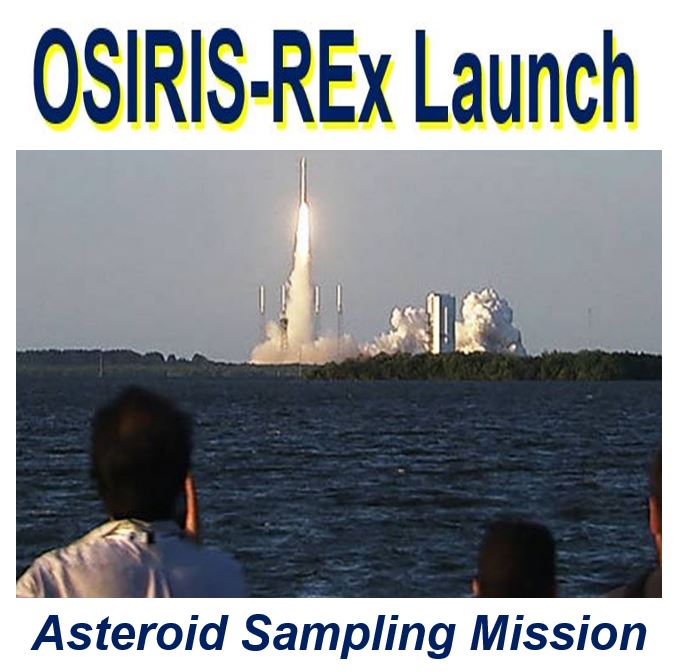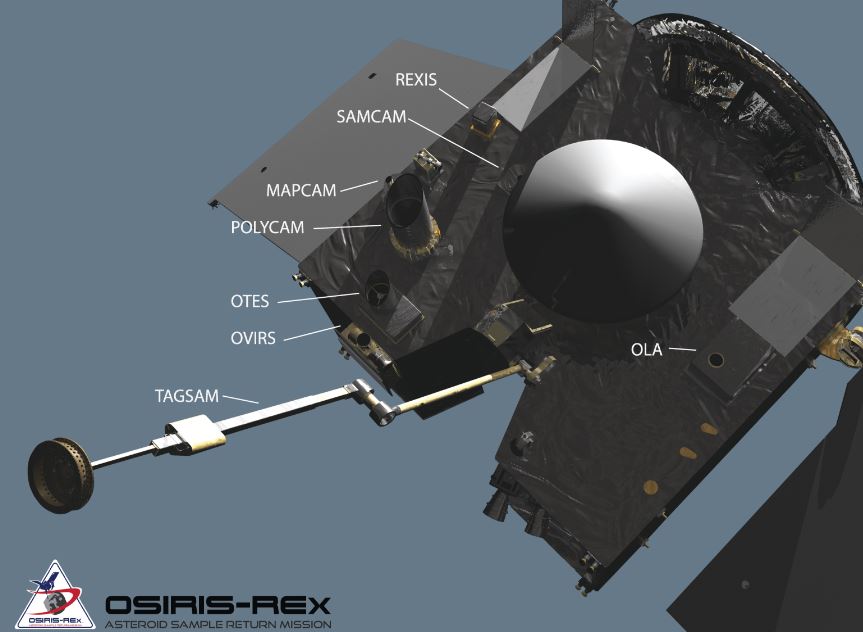NASA’s asteroid sampling mission, the first of its kind, was launched into space on Thursday evening at 7.05 p.m. EDT from Cape Canaveral Air Force Station in Florida, starting a journey that scientists believe will revolutionize their understanding of our early solar system, how Earth was formed, and how the ingredients that triggered the emergence of life got here.
OSIRIS-REx (Origins, Spectral Interpretation, Resource Identification, Security, Regolith Explorer) will study asteroid 101955 Bennu, a carbonaceous (C-type) asteroid and return a sample to Earth for analysis in 2023.
NASA scientists say that a detailed analysis of the sample should help us learn more about the formation and evolution of our solar system, the source of the organic compounds which initiated the formation of life on our planet, and the initial stages of planet formation.
 Blast off of the United Launch Alliance Atlas V rocket from Cape Canaveral Air Force Station in Florida. The rocket was carrying OSIRIS-REX, a spacecraft that will collect samples from the Bennu asteroid and bring them back to Earth for analysis. (Image: nasa.gov)
Blast off of the United Launch Alliance Atlas V rocket from Cape Canaveral Air Force Station in Florida. The rocket was carrying OSIRIS-REX, a spacecraft that will collect samples from the Bennu asteroid and bring them back to Earth for analysis. (Image: nasa.gov)
If successful, the spacecraft will be the first to return samples from an asteroid.
Asteroid Bennu
NASA Administrator, former astronaut and retired United States Marine Corps Major General, Charles Bolden, said:
“Today, we celebrate a huge milestone for this remarkable mission, and for this mission team. We’re very excited about what this mission can tell us about the origin of our solar system, and we celebrate the bigger picture of science that is helping us make discoveries and accomplish milestones that might have been science fiction yesterday, but are science facts today.”
Asteroid Bennu is a remnant from the formation of the solar system over 4.5 billion years ago.
Planetary scientists say that asteroids may have been a source of organic molecules and water for the early Earth and other planets. Precise analyses of uncontaminated samples from a known source would reveal considerably more information than what can currently be achieved by studying meteorites on Earth or asteroids in situ with spacecraft-based instruments.
The OSIRIS-REx spacecraft
At 8.04 p.m. on Thursday, OSIRIS-REx separated from its United Launch Alliance Atlas V rocket, after which solar arrays deployed and are currently powering the spacecraft, says NASA.
DYK: #OSIRISREx is expected to collect at least 60 grams of #asteroid material (size of a @Snickers candy bar)! pic.twitter.com/aw7SKDWUDC
— Lockheed Martin (@LockheedMartin) September 8, 2016
Dante Lauretta, Professor of planetary science and cosmochemistry at the University of Arizona, Tucson, and also OSIRIS-REx principal investigator, said:
“With today’s successful launch, the OSIRIS-REx spacecraft embarks on a journey of exploration to Bennu. I couldn’t be more proud of the team that made this mission a reality, and I can’t wait to see what we will discover at Bennu.”
In 2018, the probe will approach Bennu – which has a 1 in 2700 chance of crashing into Earth in the 22nd century and is the size of a mountain – and start an intricate dance with the celestial body, mapping and studying the asteroid before moving in and gathering samples.
Collecting asteroid samples
Two years later OSIRIS-Rex will perform a daring maneuver – its 11-foot arm will reach out, do a five-second high-five – which will stir up surface material – and gather at least 60 grams (2 ounces) of dust and small rocks in a sample return container.
The spacecraft will then transport the sample back to Earth in September 2023. From wherever it lands it will be taken to NASA’s Johnson Space Center in Houston, Texas, for examination.
The mission will be the first US one to transport samples from an asteroid back to our planet, and the largest sample brought back from space since the Apollo missions.
 Before selecting the asteroid’s sample site, the science team needs to know a little about Bennu’s topography. OSIRIS-REx will use a Laser Altimeter to create three-dimensional global topographic maps of Bennu and local maps of candidate sample sites. (Image: nasa.gov)
Before selecting the asteroid’s sample site, the science team needs to know a little about Bennu’s topography. OSIRIS-REx will use a Laser Altimeter to create three-dimensional global topographic maps of Bennu and local maps of candidate sample sites. (Image: nasa.gov)
Mike Donnelly, OSIRIS-REx project manager at NASA’s Goddard Space Flight Center in Greenbelt, Maryland, said:
“It’s satisfying to see the culmination of years of effort from this outstanding team. We were able to deliver OSIRIS-REx on time and under budget to the launch site, and will soon do something that no other NASA spacecraft has done – bring back a sample from an asteroid.”
About the Bennu asteroid
101955 Bennu was discovered by the LINEAR Project on 11th September, 1999. It has a mean diameter of about 492 metres (1,614 ft) and has been observed extensively by the Goldstone Deep Space Network and the Arecibo Observatory Planetary Radar.
 The OSIRIS-REx spacecraft was manufactured by Lockheed Martin. It weighs 1,529 kg (3,371 lb) and is about 3 metres (9 ft) cube. Its Sample Return Capsule will re-enter our atmosphere for a parachute-assisted landing. (Image: asteroidmission.org)
The OSIRIS-REx spacecraft was manufactured by Lockheed Martin. It weighs 1,529 kg (3,371 lb) and is about 3 metres (9 ft) cube. Its Sample Return Capsule will re-enter our atmosphere for a parachute-assisted landing. (Image: asteroidmission.org)
Bennu’s carbonaceous (consisting of or containing carbon or its compounds) material came from dying stars such as supernovae and red giants. Accretion theory says this material came together 4.5 billion years ago during our Solar System’s birth.
This asteroid’s chemical nature and basic mineralogy was probably established during the first ten million years of our Solar System’s formation, when the carbonaceous material was heated up and underwent chemical transformations, which caused more complex minerals to form.
Bennu is probably a fragment from a larger celestial body with a diameter of 100 km (62 miles) from the inner main asteroid belt. Simulations give it a 70% chance of coming from the Polana family and a 30% chance of originating from the Eulalia family.
Comet vs. Asteroid
Comets are relatively small solar system bodies that orbit the Sun. When near the Sun they display a visible coma (fuzzy outline due to solar radiation) and sometimes a tail.
Asteroids are also small solar system celestial bodies that orbit the Sun. They are similar to comets, however, they do not have a visible coma.
While asteroids are made up of metals and rocky material, comets consist of ice, dust, rocky materials and organic compounds. When a comet gets near to the Sun, it loses material with each orbit because its ice melts and vaporizes. An asteroid typically remains solid, even when close to the Sun.
Video – Asteroid myths and truths
This OSIRIS-REx Mission video explains what asteroids are, and tells us what is science fact and science fiction regarding these celestial objects.
